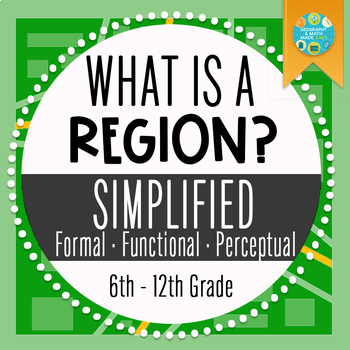NEW! Geography — Regions Simplified: Formal, Functional & Perceptual Regions
- Zip
What educators are saying
Description
Please Note: The instructor/teacher will need to know and understand the concept of REGIONS as this is a concept difficult for young brains to grasp. Even though we simplify it for students, we will need to be ready to verbally or visually explain the concept. Not all students are ready for this high-level concept. This lesson simplifies it as much as possible, but the concept, no matter how simplified, still requires high-level thinking skills and teacher guidance. It takes practice to identify the formal, functional, and perceptual regions. If the instructor/teacher doesn't understand regions, it will be difficult to instruct. This lesson is much better than our textbooks provide. Must be modified to fit your needs, this may mean omitting some of the activities included in this lesson.
This is a group reading activity with a graphic organizer comprehension activity, an at-home interview assignment (Optional), and a Powerpoint for assessment.
Updated to Include a:
-Page Long Version of the Reading Activity
-Page Shorter Version of the Reading Activity
_________________________________________________________________
Help our students understand the complicated concept of "regions."
I often found when I was teaching the 5 Geographical Themes, students grasp location, place, human-environment interaction & movement (ideas, people, goods), but they struggle with regions: formal, functional, and perceptual.
What is the difference between a formal, functional, and perceptual region?
What is a nodal point? How can there be regions that cannot be measured and are specifically based on feelings and perceptions? Can all regions be found on a map? Do they always have a clearly defined boundary?
This PowerPoint provides 7 scenarios in which students are required to decipher whether it is a formal, functional, or perceptual region. You can use it as an introduction or review. You may implement this in different ways.
INCLUDES:
o Detailed Teacher Instructions
o Intro Video Suggestion
o Intro Reading Activity
o Graphic Organizer Activity + Answer Sheet (Puzzle)
o Powerpoint Game
o Extension Activity
OBJECTIVES:
o The Learner will understand the concept “region.”
o The Learner will determine the difference between a formal, functional, and
perceptual region.
o The Learner will be able to identify a formal, functional, and perceptual region.
MATERIALS:
o Technology to have students watch the suggested intro video.
o Student Group Reading Assignment (Included)
o Technology to display material for the class to view & discuss
o Paper & timer to create a list needed for the reading activity (Action 1: Listing Game)
o Atlases for each group needed for the reading activity
o “Can You Identify the Type of Region?” PowerPoint Review Game (Included) & technology to show it
For a PowerPoint only preview, click here.
Disclaimer:
One purchase is for the use of one teacher. If additional teachers would like to use this product, please purchase additional licenses.





